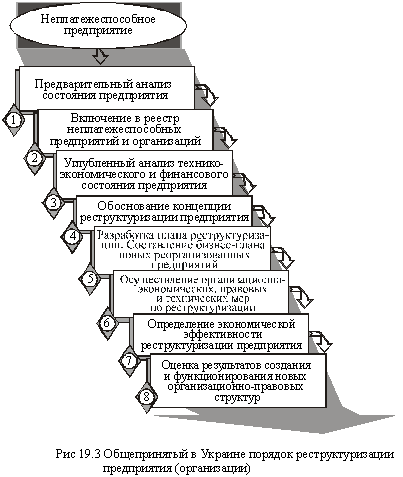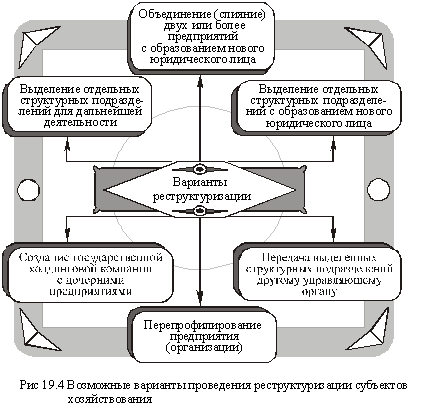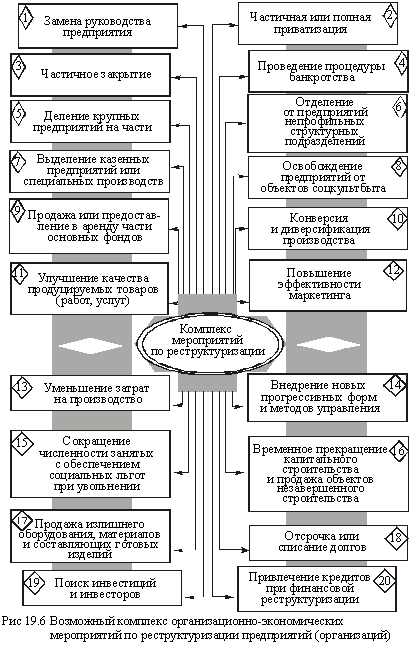home
 Economy Economy
 Business Economics - Pokropivny SF Business Economics - Pokropivny SF
|
Business Economics - Pokropivny SF
19.2 Practice implementation and effektivnostrestrukturizatsii enterprises (organizations)
The procedure, concept and restructuring options
Implementation of restructuring measures for each business entity requires an individual approach to solving the problems of his exit from the crisis.
The restructuring of enterprises (organizations) is carried out after adding them to the Registry of insolvent companies, as well as in-depth analysis of financial and economic activity of experts who formulate conclusions about the ways of improvement and propose the concept of business enterprises. A common procedure for restructuring of a business entity is shown in Fig. 19.3.

Concept of development of the enterprise in the process of developing a restructuring, depending on the conditions of its organization, production, investment, economic and foreign trade activities, personnel management, social and environmental aspects of management.
Concept development should be based on clearly defined and articulated goals of restructuring the enterprise (organization), including the following questions:
- analysis of external and internal factors influence the performance of the enterprise (organization);
- choice option (type) the restructuring of a business entity;
- justification of the strategic development of the enterprise;
- assessment of the possibilities of overcoming the difficulties in the restructuring period;
- develop a business plan for the restructured company.
Select your type of business, or the restructuring consists in choosing among several possible options that will be most meet the requirements and priorities of enterprise development, high technology manufacturing and product competitiveness. The main options for restructuring are shown in Fig. 19.4.

Forms and methods of reorganization of offices of the company are determined based on an analysis of their operation conditions. By choosing the forms and methods of reorganization, special attention should be paid to the preservation of units participating in the provision of essential public needs or the socio-economic needs of the region.
Selecting the option of restructuring carried out on the basis of assessment for the restructuring of the capacity of individual production units and the creation on their base of independent enterprises. As can be taken as the evaluation criteria:
a) the level of development of new markets (shows how quickly a separate unit of the enterprise may change the structure of sales of products and enter new markets);
b) the level of specific production of knowledge and technology (characterizes the level of application of the specific scientific and technical knowledge in the activities of units that will be unnecessary in the case of refusal to issue all kinds of previously manufactured products).
Specific production of knowledge and those hnologii include scientific and technical knowledge in the so-called pure form (technology "know-how", patents), and in the form of specific systematized knowledge acquired in the course of work on this production (the general level of technical education of workers , innovation processes). The higher level of knowledge which can be used, the unit is easier to develop new products and technologies.
These criteria include the division into one of four categories reorganized and liquidated enterprises (Fig. 19.5).

Plan for restructuring the company or other business entity usually covers:
- economic assessment of its implementation;
- proposals for specific forms and methods of restructuring of a business entity;
- solutions to the financial, social and other problems associated with the restructuring;
- the costs of restructuring and their sources of funding;
- specific measures aimed at restructuring the project object.
During the restructuring process of reorganization of the state enterprise and the transformation of its structural subdivisions (units) into independent economic entities is necessary to determine the conditions of operation of units within the enterprise, the last position on the market:
- unit (unit) is a technologically detached;
- unit (unit) is part of the integral property complex;
- unit (unit) of the enterprise independently makes products;
- unit (unit) which is engaged in the activities of non-core to the enterprise .;
- the company has a monopoly position in the market.
Implementation and evaluation of the restructuring projects
Analysis of the conditions for the functioning of offices of the company makes it possible to determine the forms and methods of its reorganization. The restructuring of enterprises is provided by the relevant organizational and economic measures (Fig. 19.6).

The choice of forms and methods of enterprise exit from the crisis depends on the expected results (potential profitability), desired deadline to achieve such results, the necessary means and capabilities to get them. The implementation of the selected measures should ensure a satisfactory state of the enterprise for the current period and the future. Thus it is necessary to take into account the social and environmental consequences of each event.
The most important condition for making decisions is their thorough feasibility study. In this connection the mandatory and necessary part of the company restructuring project is a business plan for the new companies that emerge as a result of this process.
In the process of transformation of structural subdivisions (units) into independent enterprises constitute separate balance sheets of new businesses - legal entities developed their statutes. Also, be sure the questions: a) the closure of certain production facilities; b) preservation of defense capacities; c) ensure the necessary level of mobilization readiness; g) social protection of workers and their employment; d) transfer of social infrastructure in the municipal property; e) restructuring of accounts receivable of the enterprise.
A very useful and significant work is done Ukrainian Center for Enterprise Restructuring and Private Sector Development, created in 1998 with the support of donor organizations, and especially the World Bank.
Currently, the center conducts restrukturizatsiyu25 large enterprises in 10 regions of Ukraine. Moreover, enterprises are divided into two groups. Consultants working on the first group of enterprises, diagnose, prepare and implement a restructuring plan, train staff, carry out measures to increase the sales volume of products and minimization of barter transactions, as well as are searching for foreign investors and partners. The second group of companies constitute potential bankrupts, which carried out financial restructuring, are small and medium-sized enterprises.
Here are some examples of positive restructuring carried out by the center. Thus, the center's specialists took part in the project "Financial Restructuring", carried out in the Dnipropetrovsk and Zaporizhia regions. It almost worked out procedures, business restructuring model as part of the Law of Ukraine "On restore the solvency of the debtor or recognition of his bankrupt". The Kiev JSC "Biomedsteklo" by optimizing marketing and sales functions completely eliminated barter, almost half reduced receivables. The company for the first time in recent years to profit from operating activities. Marketing Service Reorganization of JSC "Korostenhimmash" allowed almost 100 per cent increase sales and reduce by one third barter transactions. Similar positive trends observed in other enterprises involved in restructuring projects.
It is important that the restructuring of the Centre is also involved in training managers and consultants. To do this, open regional offices and established a network of training centers on the basis of industrial enterprises in several regions of Ukraine. Popular and short-term training programs and intensive training.
Now the center has sufficient manpower, tools and methods of restructuring of business entities in various sectors of the economy, the optimal decentralized infrastructure for the implementation of the project "Development of the private sector." If sufficient funding it will help to restructure 160 Ukrainian enterprises in the four pilot areas, will prepare more than 500 consultants and 2,000 managers. This will be a significant contribution to the real economy, in the training of specialists, determine the development of production and, consequently, the future competitiveness of Ukrainian enterprises.
Evaluating the effectiveness of the restructuring projects are the expected results of improved financial and economic and environmental condition of the company at the expense of resources, accelerate capital turnover while maintaining the guarantees of social protection of workers.


Comments
Commenting, keep in mind that the content and the tone of your messages can hurt the feelings of real people, show respect and tolerance to his interlocutors, even if you do not share their opinion, your behavior in terms of freedom of speech and anonymity offered by the Internet, is changing not only virtual, but real world. All comments are hidden from the index, spam control.